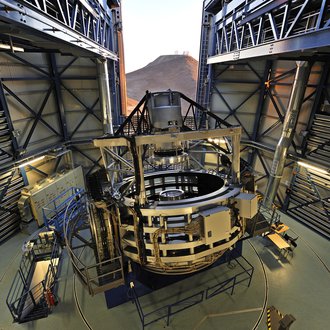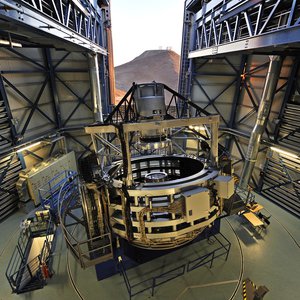Milky Way and beyond: Next Generation Survey Telescope

The VISTA telescope at the ESO Paranal Observatory in Chile.
Credit: G. Hüdepohl (atacamaphoto.com)/ESOThe 4-metre Multi-Object Spectroscopic Telescope 4MOST will be the largest spectroscopic survey facility of its kind in the Southern hemisphere and address today’s most pressing astronomical questions in the fields of Galactic archaeology, high-energy astrophysics, galaxy evolution and cosmology. With the publication of 13 papers, the consortium introduces 4MOST to the scientific community.
In a special issue of the ESO Messenger, several articles give a project overview and provide astronomers with detailed information about the first Call for Proposals, the Scientific Operations and the Survey Strategy Plan. “Also, each of the planned surveys are described, thus preparing the ESO community for the Call for Letters of Intent to use the facility, which will be released in the second half of 2019”, says Roelof de Jong, Principal Investigator of 4MOST. “This will be a singular opportunity for the astronomical community to apply to use the facility during its first five years of observation.”
4MOST is a new wide-field spectroscopic survey facility under develop¬ment for the four-metre-class Visible and Infrared Survey Telescope for Astronomy (VISTA) at Paranal in Chile. It is on one of the best observatory sites in the world and provides access to unique objects in the southern hemisphere, most notably the Galactic Centre and the Magellanic Clouds. The 4MOST design allows tens of millions of spectra to be obtained via five-year surveys, even for targets distributed over a significant fraction of the sky.
The instrument is under construction at a number of consortium institutes, coordinated by the Leibniz Institute for Astrophysics Potsdam (AIP), Germany. On the operations side, the proposal selection process starts while the manufacturing will continue into 2021. Once the subsystems are finished at the different institutes, they will all be transported to Potsdam and extensively tested as a full system. In 2022, they will be shipped to Chile and installed on the VISTA telescope.
The 4MOST operations scheme differs from other ESO instrument operations in that it allows many different science cases to be scheduled simultaneously during one observation. The science programme itself is organised into surveys centred on stellar objects to perform Galactic archaeology of different components of the Milky Way and the Magellanic Clouds, on extragalactic objects aiming to characterise cosmological parameters, the nature of dark energy and dark matter, and the formation history of galaxies and black holes. All surveys on 4MOST will be public surveys, which means that the raw data and higher-level survey products will be published in the ESO archive.
The 4MOST consortium consists of 15 institutes in Germany, the UK, France, Sweden, Switzerland, Australia, and the Netherlands, under leadership of the Leibniz Institute for Astrophysics Potsdam (AIP). More than 330 scientists and engineers are working on 4MOST and contributed to the now published articles.
4MOST consortium members
Leibniz-Institut für Astrophysik Potsdam (AIP)
Australian Astronomical Optics, Macquarie University (AAO)
Centre de Recherche Astrophysique de Lyon (CRAL)
European Southern Observatory (ESO)
Institute of Astronomy, Cambridge (IoA)
Max-Planck-Institut für Astronomie, Heidelberg (MPIA)
Max-Planck-Institut für extraterrestrische Physik, Garching (MPE)
Zentrum für Astronomie der Universität Heidelberg (ZAH)
NOVA/ASTRON, Dwingeloo
Rijksuniversiteit Groningen (RuG)
Lunds Universitet (LU)
Uppsala Universitet (UU)
Universität Hamburg (UHH)
University of Western Australia (UWA)
École polytechnique fédérale de Lausanne (EPFL)
Further information
4MOST articles in the ESO messenge
4MOST website
Images of the VISTA telescope
Press release of the Max Planck Institute for Astronomy, Heidelberg
Images
The VISTA telescope at the ESO Paranal Observatory in Chile.
Big screen size [1000 x 1000, 280 KB]
Original size [3543 x 3543, 2.0 MB]



